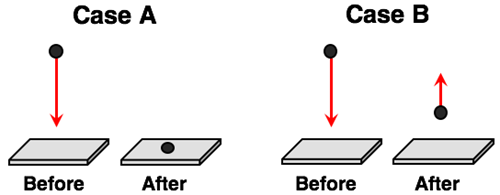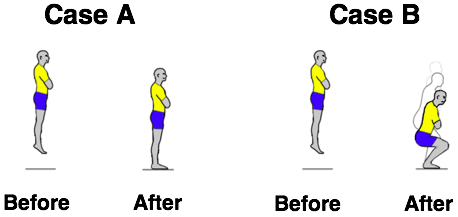Case Studies: Impulse and Force
The Case Studies: Impulse and Force Concept Builder is comprised of a bank of 16 questions that are delivered to the learner across two different difficulty levels. The 16 questions are organized into eight groups of two questions each. All questions target the learners ability to use the impulse-momentum change equation to analyze two contrasting collisions. Learners must identify the variable - velocity change, time, or mass - that is altered from one collision to the other. They must also determine which collision involves the greatest momentum change, impulse, and force.
The two difficulty levels differ only in terms of the number of contrasting collisions that must be analyzed. They can be summarized as follows:
- Master Difficulty Level: Question Groups 1-4
- Wizard Difficulty Level: Question Groups 1-8
The questions and images used in this Concept Builder are shown below. Teachers are encouraged to view the questions in order to judge which difficulty level is most appropriate for their classes.
The Physics Classroom grants teachers and other users the right to print these questions for private use. Users are also granted the right to copy the text and modify it for their own use. However, this document should not be uploaded to other servers for distribution to and/or display by others. The Physics Classroom website should remain the only website or server from which this document is distributed or displayed. We also provide a PDF that teachers can use under the same conditions. We have included a link to the PDF near the bottom of this page.
Case Studies in Collisions
Question Group 1
Question 1:
Compare the collision between two balls and the floor.
Case A: A "happy ball" collides with the floor moving at 2 m/s and rebounds upward at 1 m/s.
Case B: A "sad ball" with the same mass collides the floor moving at 2 m/s and stops.
The collision time is the same for each case.
Which variable is different for these two cases?
Which case involves the greatest momentum change? … the greatest impulse? … the greatest force?
Question 2:
Compare the collision between two balls and the floor.
Case A: A "sad ball" collides the floor moving at 2 m/s and stops.
Case B: A "happy ball" with the same mass collides with the floor moving at 2 m/s and rebounds upward at 1 m/s.
The collision time is the same for each case.

Which variable is different for these two cases?
Which case involves the greatest momentum change? … the greatest impulse? … the greatest force?
Question Group 2
Question 3:
Compare the collision between two baseballs and a catcher's mitt.
Case A: A baseball pitched at 40 m/s collides with a catcher's mitt and is brought to a stop. The catcher holds the mitt rather rigidly and retracts backwards very little as the ball strikes the mitt.
Case B: An identical baseball pitched at 40 m/s collides with a catcher's mitt and is brought to a stop. The catcher holds the mitt with a relaxed arm and reracts backwards 30 cm as the ball strikes the mitt.

Which variable is different for these two cases?
Which case involves the greatest momentum change? … the greatest impulse? … the greatest force?
Question 4:
Compare the collision between two baseballs and a catcher's mitt.
Case A: A baseball pitched at 40 m/s collides with a catcher's mitt and is brought to a stop. The catcher holds the mitt rather rigidly and retracts backwards very little as the ball strikes the mitt.
Case B: An identical baseball pitched at 40 m/s collides with a catcher's mitt and is brought to a stop. The catcher holds the mitt with a relaxed arm and reracts backwards 30 cm as the ball strikes the mitt.

Which variable is different for these two cases?
Which case involves the greatest momentum change? … the greatest impulse? … the greatest force?
Question Group 3
Question 5:
Compare these two collisions of a PE student with a wall.
Case A: A 75-kg PE student moving at 8 m/s collides with an unpadded wall and stops.
Case B: The same 75-kg PE student moving at 8 m/s collides with a padded wall and stops.
Which variable is different for these two cases?
Which case involves the greatest momentum change? … the greatest impulse? … the greatest force?
Question 6:
Compare these two collisions of a PE student with a wall.
Case A: A 75-kg PE student moving at 8 m/s collides with a padded wall and stops.
Case B: The same 75-kg PE student moving at 8 m/s collides with an unpadded wall and stops
Which variable is different for these two cases?
Which case involves the greatest momentum change? … the greatest impulse? … the greatest force?
Question Group 4
Question 7:
Compare the catching of two different water balloons.
Case A: A 600-mL water balloon moving at 8 m/s is caught and brought to a stop.
Case B: A 150-mL water balloon moving at 8 m/s is caught with the same technique and brought to a stop.
The collision time is the same for each case.
Which variable is different for these two cases?
Which case involves the greatest momentum change? … the greatest impulse? … the greatest force?
Question 8:
Compare the catching of two different water balloons.
Case A: A 150-mL water balloon moving at 8 m/s is caught and brought to a stop.
Case B: A 600-mL water balloon moving at 8 m/s is caught with the same technique and brought to a stop.
The collision time is the same for each case.
Which variable is different for these two cases?
Which case involves the greatest momentum change? … the greatest impulse? … the greatest force?
Question Group 5
Question 9:
Compare these two collisions of a driver in a car.
Case A: A 50-kg car driver moving at 12 m/s is stopped by an air bag during a front-end collision.
Case B: The same 50-kg car driver moving at 12 m/s is stopped by a dashboard during a front-end collision.
Which variable is different for these two cases?
Which case involves the greatest momentum change? … the greatest impulse? … the greatest force?
Question 10:
Compare these two collisions of a driver in a car.
Case A: A 50-kg car driver moving at 12 m/s is stopped by a dashboard during a front-end collision.
Case B: The same 50-kg car driver moving at 12 m/s is stopped by an air bag during a front-end collision.
Which variable is different for these two cases?
Which case involves the greatest momentum change? … the greatest impulse? … the greatest force?
Question Group 6
Question 11:
Compare these two collisions of a car during a crash test.
Case A: A 1200-kg car moving at 18 m/s collides with a barrier and crumples up as it stops.
Case B: The same 1200-kg car moving at 18 m/s collides with a barrier and bounces backward with a speed of 6 m/s.
Which variable is different for these two cases?
Which case involves the greatest momentum change? … the greatest impulse? … the greatest force?
The collision time is the same for each case.
Question 12:
Compare these two collisions of a car during a crash test.
Case A: A 1200-kg car moving at 18 m/s collides with a barrier and bounces backward with a speed of 6 m/s.
Case B: The same 1200-kg car moving at 18 m/s collides with a barrier and crumples up as it stops.

Which variable is different for these two cases?
Which case involves the greatest momentum change? … the greatest impulse? … the greatest force?
The collision time is the same for each case.
Question Group 7
Question 13:
Compare the collision of a gymnast with the floor using two different landing strategies.
Case A: A gymnast strikes the floor with a speed of 12 m/s with relatively stiff-knees as she comes to a stop.
Case B: The same gymnast strikes the floor with a speed of 12 m/s with relaxed knees and some bending as she comes to a stop.

Which variable is different for these two cases?
Which case involves the greatest momentum change? … the greatest impulse? … the greatest force?
Question 14:
Compare the collision of a gymnast with the floor using two different landing strategies.
Case A: A gymnast strikes the floor with a speed of 12 m/s with relaxed knees and some bending as she comes to a stop.
Case B: The same gymnast strikes the floor with a speed of 12 m/s with relatively stiff-knees as she comes to a stop.
Which variable is different for these two cases?
Which case involves the greatest momentum change? … the greatest impulse? … the greatest force?
Question Group 8
Question 15:
Compare these two collisions of an egg with the floor.
Case A: A Jumbo egg is released from a 1-meter height; it falls to the ground and stops.
Case B: The same Jumbo egg is released from a 5-meter height; it falls to the ground and stops.
The collision time is the same for each case.
Which variable is different for these two cases?
Which case involves the greatest momentum change? … the greatest impulse? … the greatest force?
Question 16:
Compare these two collisions of an egg with the floor.
Case A: A Jumbo egg is released from a 5-meter height; it falls to the ground and stops.
Case B: The same Jumbo egg is released from a 1-meter height; it falls to the ground and stops.
The collision time is the same for each case.
Which variable is different for these two cases?
Which case involves the greatest momentum change? … the greatest impulse? … the greatest force?